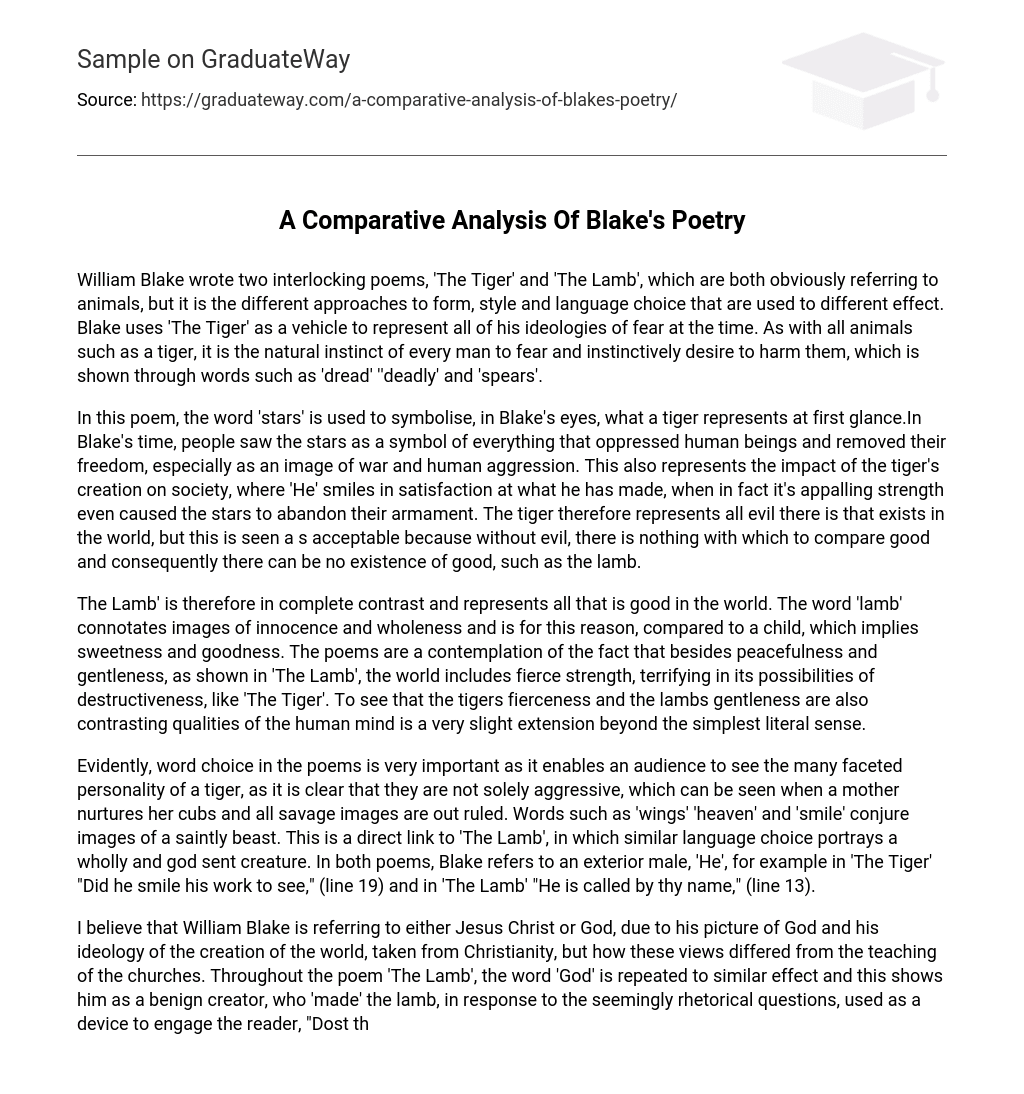The poems ‘The Tiger’ and ‘The Lamb’ by William Blake focus on animals, but they employ distinct techniques in terms of structure, style, and language to achieve different effects. In ‘The Tiger’, Blake utilizes the animal as a metaphor to convey his prevailing fears. Similar to the inherent human instinct to fear and harm creatures like tigers, the poem employs words like ‘dread’, ‘deadly’, and ‘spears’.
The poem uses the word ‘stars’ to symbolize what a tiger represents at first glance. In Blake’s time, stars were seen as a symbol of oppression and the removal of freedom, particularly as an image of war and human aggression. This also represents how the tiger’s creation impacts society, as ‘He’ smiles in satisfaction at what he has made, even though its appalling strength caused the stars to abandon their armament. Therefore, the tiger represents all the evil that exists in the world, but this is seen as acceptable because without evil, there would be nothing to compare to good. As a result, good would not exist, just like the lamb.
The poem ‘The Lamb’ illustrates all that is good in the world, serving as a complete contrast to other aspects. The term ‘lamb’ symbolizes innocence and wholeness, akin to the sweetness and goodness associated with a child. These poems contemplate the peacefulness and gentleness depicted in ‘The Lamb’ alongside the fierce strength and destructive potential found in ‘The Tiger’. Additionally, they suggest that the contrasting qualities of the human mind, such as the fierceness of a tiger and the gentleness of a lamb, are only a slight extension beyond their literal interpretation.
The poems emphasize the importance of word choice and its ability to showcase the multifaceted nature of a tiger. It is evident that they are not solely aggressive, as seen when a mother nurtures her cubs and savage images are disregarded. Words like ‘wings’, ‘heaven’, and ‘smile’ evoke images of a saintly beast. This directly connects to ‘The Lamb’, where similar language portrays a divine creature. Both poems reference an external male figure, using ‘He’ — for example, in ‘The Tiger’ “Did he smile his work to see,” (line 19) and in ‘The Lamb’ “He is called by thy name,” (line 13).
In my belief, William Blake is suggesting that he is referring to either Jesus Christ or God. This is evident through his depiction of God and his ideas on the creation of the world, which are influenced by Christianity. However, Blake’s views differ from those taught by the churches. Throughout the poem ‘The Lamb’, the word ‘God’ is recurrently used. This repetition portrays God as a benevolent creator who brought forth the existence of the lamb. The rhetorical questions employed in the poem serve as a device to engage the reader, such as when Blake asks, “Dost thou know who made thee?” The same concept is reiterated in ‘The Tiger’ as it directly references both the lamb and the entity that created both animals. Blake further questions whether it is possible for one individual to have crafted two intricately delicate yet distinctly dissimilar creatures by asking, “Did he who made the lamb make thee?” Additionally, the line “What immortal hand or eye, Could frame thy fearful symmetry,” speaks to the tiger’s exquisite beauty and implies that no mortal being could have possibly crafted such a masterpiece, reinforcing the idea of an all-powerful God.
The theme of power struggle between strength and weakness is depicted in both poems. In the poem “The Lamb,” the constant reference to the lamb as ‘little’ is emphasized through alliteration of the letter ‘l’. This stands in contrast to the tiger’s somewhat mechanical qualities. “The Tiger” presents a second semantic field that showcases the animal’s immense size and sheer strength, evident through the deliberate choice of words like ‘hammer’, ‘chain’, and ‘anvil’. Additionally, color plays a significant role in “The Tiger,” specifically in another semantic field related to fire.
The author uses words like “burnt”, “fire”, and “burning” to create an image of reds and oranges, which are associated with danger and threat, similar to the personality attributed to the tiger. The phrase “burning bright”, highlighted by alliteration, can represent the tiger as a symbol of a “burning” quality, encompassing wrath and passion. However, the word “bright” also conveys incandescence and white heat, bringing a sense of glory and radiance. Both poems maintain a strong rhythmic structure, symbolizing stability in the content and mirroring the movement of the animal in “The Tiger”.
The powerful rhythm of the poems shows the slow and perhaps stalking movement of the tiger. Both ‘The Tiger’ and ‘The Lamb’ have a steady rhyming pattern wherein each stanza consists of rhyming couplets to emphasize the message. Repetition is continuously used in both poems. For instance, the first stanza is repeated in ‘The Tiger’ to create an equal number of stanzas, reflecting the balanced nature of the animal while adding emphasis. Additionally, both poems consist entirely of rhetorical questions, engaging the audience.
Blake’s rhythms in The Lamb provide a sense of completion by answering these questions. The rhythms are simultaneously forceful and supple, with some being based on ballad metres and others being metrically free and influenced by the bible. However, all of them ultimately return to the rhythm of speech.





